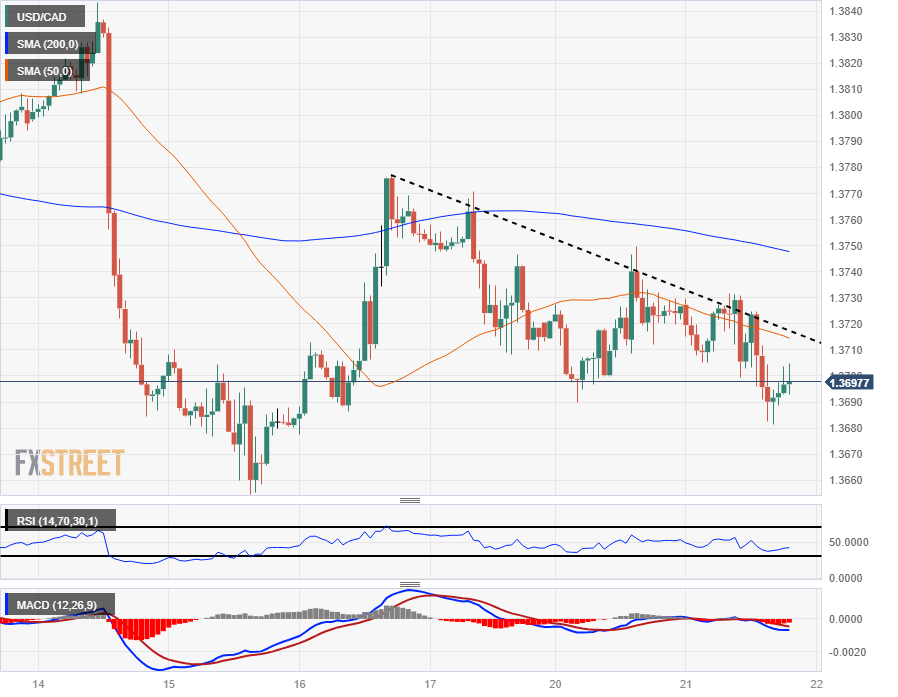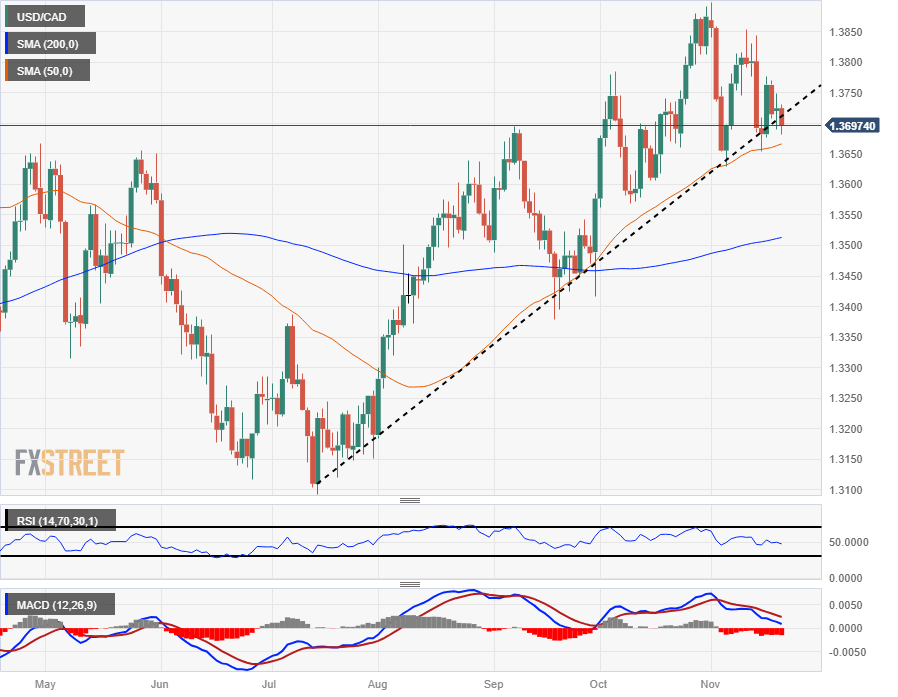Canadian Dollar higher on the day, but topside momentum remains thin
- The Canadian Dollar is seeing higher bids on Tuesday, but momentum remains thin.
- Fed’s latest Meeting Minutes reveal little new, FOMC leery about future rates.
- Crude Oil is grinding sideways above $77.00, limiting CAD support.
The Canadian Dollar (CAD) is struggling to claim further upside against the US Dollar (USD). Loonie momentum remains limited with Crude Oil spinning in place and investors focusing on the Federal Reserve’s (Fed) latest Meeting Minutes.
Fed Meeting Minutes showed the Federal Open Market Commission unanimously remains committed to keeping rates pinned as high as they need them to be until forward-looking inflation expectations decline. At last tally, overall inflation expectations are expected to continue easing back through 2024 before turning back higher in 2025, with growing potential for inflation to miss the Fed's 2% target.
Canadian Consumer Price Index (CPI) inflation figures missed expectations in the annualized headline number, and the Bank of Canada’s (BoC) Core CPI was mixed between the monthly and annual results.
Daily Digest Market Movers: Canadian Dollar finds little legroom, moves remain tight
- Canadian headline CPI inflation in October missed expectations in the annualized figure, coming in at 3.1% versus the forecast of 3.2%, backsliding from the previous 3.8%.
- MoM CPI printed as expected at 0.1%, rebounding slightly from September’s -0.1% decline.
- Core CPI lurched higher to 0.3% against the previous -0.1%.
- The BoC’s own YoY Core CPI watchlist shed some weight in October, coming down to 2.7% from 2.8%.
- Markets focused on Fed's Meeting Minutes, policymakers remain committed to higher rates for as long as necessary, rates still seen high through the front half of 2024.
- Crude Oil is churning in the $77.00/barrel region, providing little support for the Loonie.
- FOMC minutes: Further tightening would be appropriate if progress toward inflation objective was insufficient
Canadian Dollar price today
The table below shows the percentage change of Canadian Dollar (CAD) against listed major currencies today. Canadian Dollar was the strongest against the Euro.
| USD | EUR | GBP | CAD | AUD | JPY | NZD | CHF | |
| USD | 0.32% | -0.19% | -0.20% | 0.12% | 0.04% | -0.13% | -0.04% | |
| EUR | -0.32% | -0.49% | -0.52% | -0.17% | -0.29% | -0.45% | -0.35% | |
| GBP | 0.19% | 0.52% | 0.00% | 0.35% | 0.25% | 0.07% | 0.16% | |
| CAD | 0.20% | 0.52% | 0.02% | 0.36% | 0.24% | 0.07% | 0.16% | |
| AUD | -0.12% | 0.23% | -0.29% | -0.30% | -0.05% | -0.23% | -0.12% | |
| JPY | -0.04% | 0.28% | -0.22% | -0.26% | 0.08% | -0.18% | -0.09% | |
| NZD | 0.13% | 0.45% | -0.06% | -0.07% | 0.29% | 0.17% | 0.09% | |
| CHF | 0.01% | 0.37% | -0.16% | -0.16% | 0.15% | 0.10% | -0.09% |
The heat map shows percentage changes of major currencies against each other. The base currency is picked from the left column, while the quote currency is picked from the top row. For example, if you pick the Euro from the left column and move along the horizontal line to the Japanese Yen, the percentage change displayed in the box will represent EUR (base)/JPY (quote).
Technical Analysis: Canadian Dollar struggles to capitalize but looks for further gains against the US Dollar
The Canadian Dollar (CAD) is on the rise against the US Dollar (USD) in Tuesday’s trading, but topside momentum remains limited and the USD/CAD is seeing hesitation after slipping below the 1.3700 handle.
The pair remains capped on the low end after catching a downside bounce from the 200-hour Simple Moving Average (SMA) last week.
The short-term technical barriers for intraday trading will be last week’s low bids near 1.3660 and the USD/CAD’s bearish rejection of the 200-hour SMA at 1.3770.
Tuesday’s bearish action sees the pair experimenting with a downside break of a bullish trendline from July’s swing low into the 1.3100 handle. Technical support is stacked from the 50-day SMA near 1.3665 and the 200-day SMA rising from 1.3500.
USD/CAD Hourly Chart
 USD/CAD Daily Chart
USD/CAD Daily Chart

Canadian Dollar FAQs
What key factors drive the Canadian Dollar?
The key factors driving the Canadian Dollar (CAD) are the level of interest rates set by the Bank of Canada (BoC), the price of Oil, Canada’s largest export, the health of its economy, inflation and the Trade Balance, which is the difference between the value of Canada’s exports versus its imports. Other factors include market sentiment – whether investors are taking on more risky assets (risk-on) or seeking safe-havens (risk-off) – with risk-on being CAD-positive. As its largest trading partner, the health of the US economy is also a key factor influencing the Canadian Dollar.
How do the decisions of the Bank of Canada impact the Canadian Dollar?
The Bank of Canada (BoC) has a significant influence on the Canadian Dollar by setting the level of interest rates that banks can lend to one another. This influences the level of interest rates for everyone. The main goal of the BoC is to maintain inflation at 1-3% by adjusting interest rates up or down. Relatively higher interest rates tend to be positive for the CAD. The Bank of Canada can also use quantitative easing and tightening to influence credit conditions, with the former CAD-negative and the latter CAD-positive.
How does the price of Oil impact the Canadian Dollar?
The price of Oil is a key factor impacting the value of the Canadian Dollar. Petroleum is Canada’s biggest export, so Oil price tends to have an immediate impact on the CAD value. Generally, if Oil price rises CAD also goes up, as aggregate demand for the currency increases. The opposite is the case if the price of Oil falls. Higher Oil prices also tend to result in a greater likelihood of a positive Trade Balance, which is also supportive of the CAD.
How does inflation data impact the value of the Canadian Dollar?
While inflation had always traditionally been thought of as a negative factor for a currency since it lowers the value of money, the opposite has actually been the case in modern times with the relaxation of cross-border capital controls. Higher inflation tends to lead central banks to put up interest rates which attracts more capital inflows from global investors seeking a lucrative place to keep their money. This increases demand for the local currency, which in Canada’s case is the Canadian Dollar.
How does economic data influence the value of the Canadian Dollar?
Macroeconomic data releases gauge the health of the economy and can have an impact on the Canadian Dollar. Indicators such as GDP, Manufacturing and Services PMIs, employment, and consumer sentiment surveys can all influence the direction of the CAD. A strong economy is good for the Canadian Dollar. Not only does it attract more foreign investment but it may encourage the Bank of Canada to put up interest rates, leading to a stronger currency. If economic data is weak, however, the CAD is likely to fall.